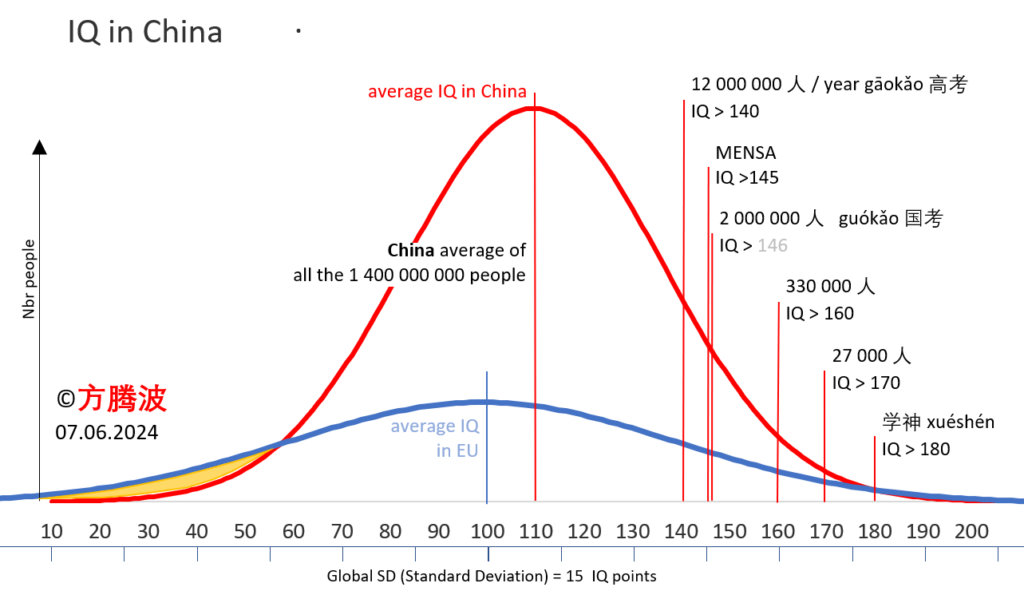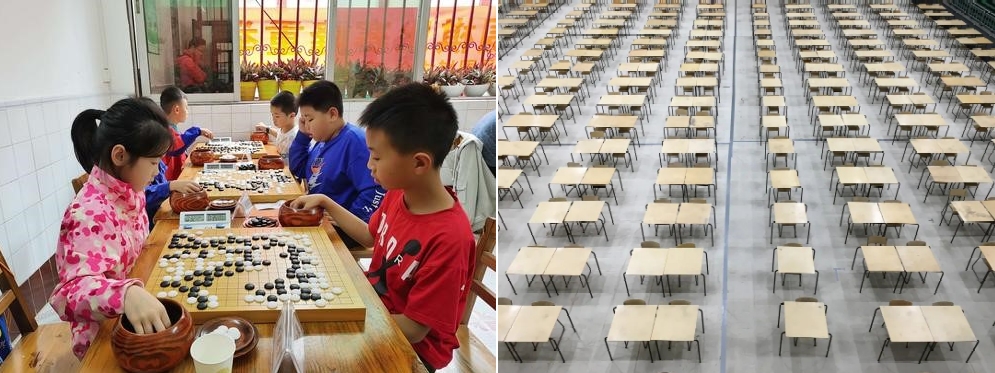Abstract:Two decades after "The Bell Curve", it is becoming abundantly clear that the gap has become unbridgeable. This will inevitably have major consequences for developments in world politics in the coming decades.
Views: 264
China’s cohort of extraordinary intelligent people.
Frans Vandenbosch 方腾波 12.06.2024

This whole article is about a taboo, the biggest taboo in the United States.
Back in 1994…
Back in 1994, The Bell Curve was published. The book, full title “The Bell Curve: Intelligence and Class Structure in American Life” by political scientist Charles Murray and psychologist Richard J. Herrnstein right away stirred up the American academic world and the mainstream media. They found it perverse to claim that there are significant IQ differences between human races. Even worse: the bare figures showed that NE Asian people (China, Japan, Korea) have an average IQ of no less than 10 points more than the average American.
That took some time to recover from. Despite the evidence being so overwhelming and the sources and IQ measures so numerous, it took almost a decade for this to become widely accepted in the US.
But still today, IQ remains a big taboo in the West. In the USA, people can talk more openly about incestual relationships, paedophilia, polygamy and race than about IQ.
Human worth
The moral value of people (another taboo !) was already extensively researched 2500 years ago. Both Confucius (551 – 479 BCE) and shortly after him also Plato (424 – 347 BCE) classified the morality of people into 6 categories. For them, people are classified according to their increasing moral development going in parallel with their intellectual and practical achievements. It was understood that the more someone understands (inner and outer) reality and is able to do things properly, the more he will be able to be free from his ego-centred preoccupations and consequently will truly care for the others and will be ready to provide the appropriate help, skilfully and in a respectful manner when needed.
Confucius relied heavily on the I Ching (c. 1000 BCE) for his Eight Trigrams theory, while Plato based his Politeia theory on Socrates (470 – 399 BCE).
Today, Nathan Cofnas, philosopher of biology at Cambridge, recently provided an affirmative answer to the question, “Are Smart People Superior?” Cofnas argued that moral worth is proportional to intelligence, all else being equal, because human intelligence is both instrumentally and intrinsically valuable.[1]
Both Charles Murray and Noah Carl avoid to define the terms “human worth” or “moral worth”. That’s too easy a way to avoid the real debate. They should have read Confucius’ Eight Trigrams or Plato’s Politeia.
Call a spade a spade
For a population where the average IQ is 100 points, the following descriptive classifications of intelligence quotients apply:
| Descriptive Classifications of Intelligence quotients | |||
| Nr. | IQ | Description | % of population |
| 1 | > 130 | Very superior | 2.2% |
| 2 | 120 – 129 | Superior | 6.7% |
| 3 | 110 – 119 | High average | 16.1% |
| 4 | 90 – 109 | Average | 50.0% |
| 5 | 80 – 89 | Low average | 16.1% |
| 6 | 70 – 79 | Borderline | 6.7% |
| 7 | < 70 | Extremely low | 2.2% |
In this context, read about the capabilities of each of those groups in ‘The 7 Tribes of Intellect‘
In China
China has, because of several reasons, an extremely high number of high IQ people. Let’s first have a look at the naked figures:
| China | ||||
| IQ | nbr._of_people | |||
| China | The whole population | average | IQ 110 | 1 400 000 000 |
| gāokǎo 高考 | Nationwide Unified Examination for Admissions to General Universities and Colleges | more than | IQ 140 | 12 000 000 / year |
| guókǎo 国考 | National Civil Service Administration Exam | more than | IQ 146 | 3 300 000 / year |
| MENSA | Mensa is a non-profit organisation open to people who score at the 98th percentile or higher on a standardised, supervised IQ intelligence test. | more than | IQ 145 | |
| 4 SD | People with 4 Standard Deviations above the average | more than | IQ 160 | 330 000 |
| People with an extremely high IQ | more than | IQ 170 | 27 000 | |
| xuéshén 学神 | The “Study Gods” | more than | IQ 180 |
The Bell curve
These same figures, plotted on a Gaussian curve (normal distribution, sometimes called a bell curve) looks like this:

Standard Deviation
To interpret this graph correctly, we first have to know what’s a SD, Standard Deviation.
The most common definition of standard deviation (SD) in the context of IQ is a statistical measure of the dispersion or spread of IQ scores around the mean. In the case of IQ tests, which are typically standardized to have a mean of 100 and a standard deviation of 15 in the general population, the standard deviation represents the average amount by which individual IQ scores deviate from the mean IQ score of 100.
In practical terms, a standard deviation of 15 means that about 68% of the population will have IQ scores falling within one standard deviation (15 points) of the mean (between 85 and 115), about 95% will fall within two standard deviations (between 70 and 130), and about 99.7% will fall within three standard deviations (between 55 and 145).
This definition allows for a standardized comparison of IQ scores across different populations and individuals, regardless of the specific IQ test used.
Remarkable Differences in Standard Deviation
Steve Hsu: (Professor of Theoretical Physics and of Computational Mathematics, Science, and Engineering) Asian-White IQ variance from PISA results: The vexing question of average differences between groups of humans has been the subject of scrutiny for a very long time. Differences in variance or standard deviation (SD) are less well understood, but have important implications as well. This point was emphasized during the Larry Summers debacle, in which he posited that the variance in male intelligence might be larger than for women, even though the averages are similar (more very dumb and very bright men than women). Summers argued that this effect might explain the preponderance of males in science and engineering (the high IQ’s), even for a very small difference in SD.[2]
The Larry Summers theorem is supported by several recent studies, meaning that there may be more men at the extreme ends of the IQ distribution (both very high and very low IQ scores)
Something similar, a difference of standard deviation between Northeast Asian and European people has been found. Just about all Western populations report a standard deviation of 15 IQ points. But, remarkably, the SD for the East Asian populations (China, Japan Korea) appears to be a shade under 13 IQ points. (Steve Hsu)
Note that the somewhat smaller standard deviation in China, combined with the 10 points lower IQ of European people (compared to Chinese) is causing a gap at the bottom left of the bell curve. The area in yellow is indicating the significant higher number of European people with an extremely low IQ, compared to China.
By the way: the average IQ in the United States is 1 point lower than Western Europe, making the yellow “danger area” even larger.
The whiz kids
China has three times the population of Europe and four times the population of the USA. In my article ‘The brain game kicked off,’ I have already elaborated extensively on the qualities of the Chinese education system. Godfree Roberts explained in ‘How China selects its governing elite‘ why China, throughout history, has placed such exceptional emphasis on education. Both in politics and education, the gap with our Western society is strikingly clear, visible to the naked eye. This will inevitably have major consequences for developments in world politics in the coming decades.
..

Conclusion
In summary, I must conclude that the phenomenon of extremely high IQ in China the result is of a complex interplay of historical, cultural, and modern factors. The country’s long-standing emphasis on education, rigorous academic systems, supportive cultural values, and advancements in technology have collectively created an environment where intellectual achievement is highly valued and nurtured. As China continues to evolve and innovate, it is likely that the intellectual capabilities of its population will continue to grow, solidifying its position as a global leader in science, education and intellectual achievement.
[1] Joel Carini: “Is Human Worth Normally Distributed?” Aporia Magazine, 14.05.2024.
https://www.aporiamagazine.com/p/is-human-worth-normally-distributed?
[2] Steve Hsu: (Professor of Theoretical Physics and of Computational Mathematics, Science, and Engineering) Asian-White IQ variance from PISA results. https://infoproc.blogspot.com/2008/06/asian-white-iq-variance-from-pisa.html


